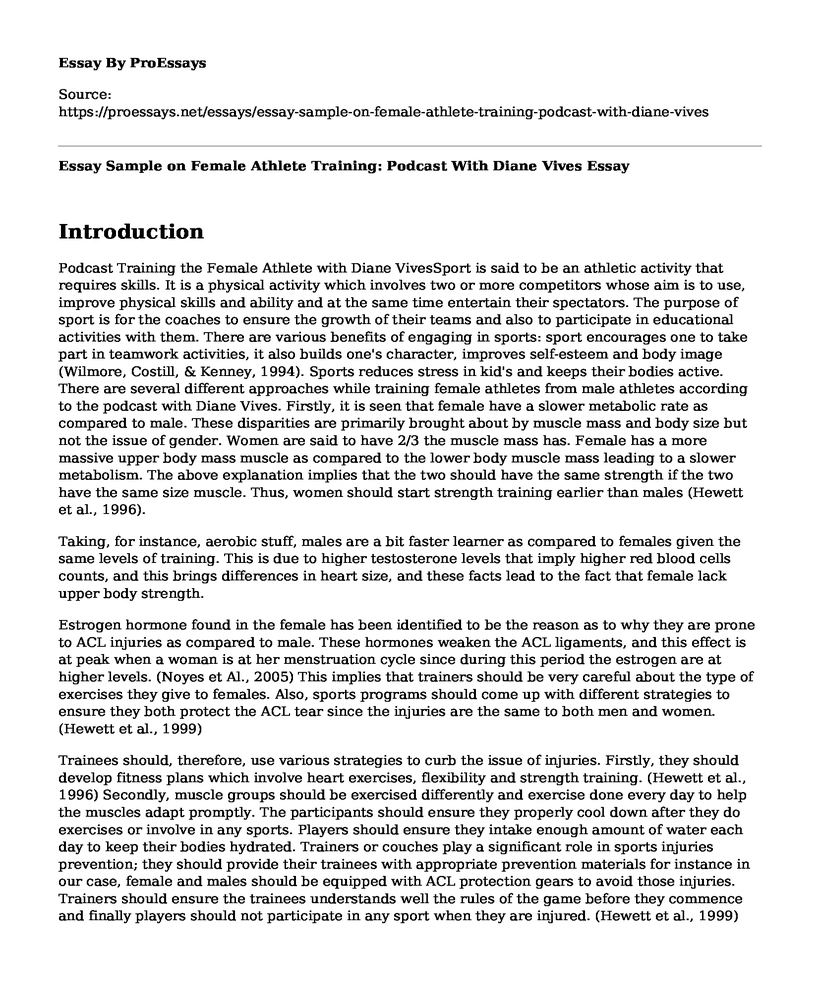Introduction
Podcast Training the Female Athlete with Diane VivesSport is said to be an athletic activity that requires skills. It is a physical activity which involves two or more competitors whose aim is to use, improve physical skills and ability and at the same time entertain their spectators. The purpose of sport is for the coaches to ensure the growth of their teams and also to participate in educational activities with them. There are various benefits of engaging in sports: sport encourages one to take part in teamwork activities, it also builds one's character, improves self-esteem and body image (Wilmore, Costill, & Kenney, 1994). Sports reduces stress in kid's and keeps their bodies active. There are several different approaches while training female athletes from male athletes according to the podcast with Diane Vives. Firstly, it is seen that female have a slower metabolic rate as compared to male. These disparities are primarily brought about by muscle mass and body size but not the issue of gender. Women are said to have 2/3 the muscle mass has. Female has a more massive upper body mass muscle as compared to the lower body muscle mass leading to a slower metabolism. The above explanation implies that the two should have the same strength if the two have the same size muscle. Thus, women should start strength training earlier than males (Hewett et al., 1996).
Taking, for instance, aerobic stuff, males are a bit faster learner as compared to females given the same levels of training. This is due to higher testosterone levels that imply higher red blood cells counts, and this brings differences in heart size, and these facts lead to the fact that female lack upper body strength.
Estrogen hormone found in the female has been identified to be the reason as to why they are prone to ACL injuries as compared to male. These hormones weaken the ACL ligaments, and this effect is at peak when a woman is at her menstruation cycle since during this period the estrogen are at higher levels. (Noyes et Al., 2005) This implies that trainers should be very careful about the type of exercises they give to females. Also, sports programs should come up with different strategies to ensure they both protect the ACL tear since the injuries are the same to both men and women. (Hewett et al., 1999)
Trainees should, therefore, use various strategies to curb the issue of injuries. Firstly, they should develop fitness plans which involve heart exercises, flexibility and strength training. (Hewett et al., 1996) Secondly, muscle groups should be exercised differently and exercise done every day to help the muscles adapt promptly. The participants should ensure they properly cool down after they do exercises or involve in any sports. Players should ensure they intake enough amount of water each day to keep their bodies hydrated. Trainers or couches play a significant role in sports injuries prevention; they should provide their trainees with appropriate prevention materials for instance in our case, female and males should be equipped with ACL protection gears to avoid those injuries. Trainers should ensure the trainees understands well the rules of the game before they commence and finally players should not participate in any sport when they are injured. (Hewett et al., 1999)
Conclusion
In conclusion, Vives was right when she said that female and male require a different type of exercises based on their body composition, intensity, and vulnerability to ACL injuries as explained above
References
Hewett, T. E., Lindenfeld, T. N., Riccobene, J. V., & Noyes, F. R. (1999). The effect of neuromuscular training on the incidence of knee injury in female athletes. The American journal of sports medicine, 27(6), 699-706. https://pdfs.semanticscholar.org/5399/06d3c280243a66a1f37a4b7f38a5006cf5cd.pdf
Hewett, T. E., Stroupe, A. L., Nance, T. A., & Noyes, F. R. (1996). Plyometric training in female athletes: decreased impact forces and increased hamstring torques. The American journal of sports medicine, 24(6), 765-773. http://ptee.s3.amazonaws.com/wp-content/uploads/2014/04/Hewett-1996-AJSM.pdf
Noyes, F. R., Barber-Westin, S. D., Fleckenstein, C., Walsh, C., & West, J. (2005). The drop-jump screening test: difference in lower limb control by gender and the effect of neuromuscular training in female athletes. The American journal of sports medicine, 33(2), 197-207. https://www.researchgate.net/profile/Sue_Barber-Westin/publication/8030503_The_drop-jump_screening_test_difference_in_lower_limb_control_by_gender_and_effect_of_neuromuscular_training_in_female_athletes/links/09e4150b6015734a94000000.pdf
Wilmore, J. H., Costill, D. L., & Kenney, W. L. (1994). Physiology of sport and exercise. http://www.academia.edu/download/6274962/physiology-of-sport-and-exercise-fourth-edition.pdf
Cite this page
Essay Sample on Female Athlete Training: Podcast With Diane Vives. (2023, Jan 03). Retrieved from https://proessays.net/essays/essay-sample-on-female-athlete-training-podcast-with-diane-vives
If you are the original author of this essay and no longer wish to have it published on the ProEssays website, please click below to request its removal:
- How Diet and Exercise Impact On the Mind? - Essay Sample
- Football, Rape Culture, and the Neoliberal University (as) Brand
- The Relationship Between Physical Fitness and Lifeguarding - Essay Sample
- Essay Sample on 1985 Chicago Bears: Rules, Norms & Unrepeated Success
- Essay Example on Supplements: Enhancing Exercise & Athletic Performance
- Essay Example on Athletes for Change: The Power of Sports for Social Change
- Essay Sample on Fitness Walking Program Benefits: Mental, Physical, Other







